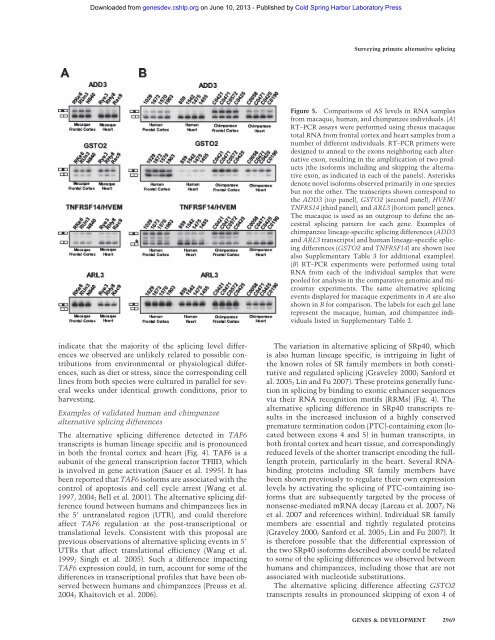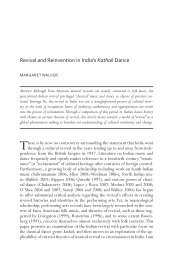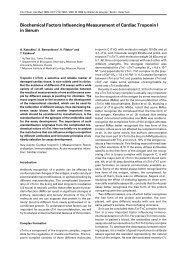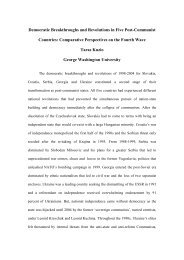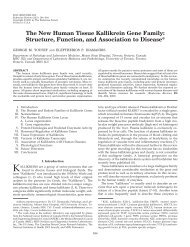Calarco et al 2007 - University of Toronto
Calarco et al 2007 - University of Toronto
Calarco et al 2007 - University of Toronto
- No tags were found...
You also want an ePaper? Increase the reach of your titles
YUMPU automatically turns print PDFs into web optimized ePapers that Google loves.
Downloaded from genesdev.cshlp.org on June 10, 2013 - Published by Cold Spring Harbor Laboratory PressSurveying primate <strong>al</strong>ternative splicingFigure 5. Comparisons <strong>of</strong> AS levels in RNA samplesfrom macaque, human, and chimpanzee individu<strong>al</strong>s. (A)RT–PCR assays were performed using rhesus macaqu<strong>et</strong>ot<strong>al</strong> RNA from front<strong>al</strong> cortex and heart samples from anumber <strong>of</strong> different individu<strong>al</strong>s. RT–PCR primers weredesigned to anne<strong>al</strong> to the exons neighboring each <strong>al</strong>ternativeexon, resulting in the amplification <strong>of</strong> two products(the is<strong>of</strong>orms including and skipping the <strong>al</strong>ternativeexon, as indicated in each <strong>of</strong> the panels). Asterisksdenote novel is<strong>of</strong>orms observed primarily in one speciesbut not the other. The transcripts shown correspond tothe ADD3 (top panel), GSTO2 (second panel), HVEM/TNFRS14 (third panel), and ARL3 (bottom panel) genes.The macaque is used as an outgroup to define the ancestr<strong>al</strong>splicing pattern for each gene. Examples <strong>of</strong>chimpanzee lineage-specific splicing differences (ADD3and ARL3 transcripts) and human lineage-specific splicingdifferences (GSTO2 and TNFRSF14) are shown (see<strong>al</strong>so Supplementary Table 3 for addition<strong>al</strong> examples).(B) RT–PCR experiments were performed using tot<strong>al</strong>RNA from each <strong>of</strong> the individu<strong>al</strong> samples that werepooled for an<strong>al</strong>ysis in the comparative genomic and microarrayexperiments. The same <strong>al</strong>ternative splicingevents displayed for macaque experiments in A are <strong>al</strong>soshown in B for comparison. The labels for each gel lanerepresent the macaque, human, and chimpanzee individu<strong>al</strong>slisted in Supplementary Table 2.indicate that the majority <strong>of</strong> the splicing level differenceswe observed are unlikely related to possible contributionsfrom environment<strong>al</strong> or physiologic<strong>al</strong> differences,such as di<strong>et</strong> or stress, since the corresponding celllines from both species were cultured in par<strong>al</strong>lel for sever<strong>al</strong>weeks under identic<strong>al</strong> growth conditions, prior toharvesting.Examples <strong>of</strong> v<strong>al</strong>idated human and chimpanzee<strong>al</strong>ternative splicing differencesThe <strong>al</strong>ternative splicing difference d<strong>et</strong>ected in TAF6transcripts is human lineage specific and is pronouncedin both the front<strong>al</strong> cortex and heart (Fig. 4). TAF6 is asubunit <strong>of</strong> the gener<strong>al</strong> transcription factor TFIID, whichis involved in gene activation (Sauer <strong>et</strong> <strong>al</strong>. 1995). It hasbeen reported that TAF6 is<strong>of</strong>orms are associated with thecontrol <strong>of</strong> apoptosis and cell cycle arrest (Wang <strong>et</strong> <strong>al</strong>.1997, 2004; Bell <strong>et</strong> <strong>al</strong>. 2001). The <strong>al</strong>ternative splicing differencefound b<strong>et</strong>ween humans and chimpanzees lies inthe 5 untranslated region (UTR), and could thereforeaffect TAF6 regulation at the post-transcription<strong>al</strong> ortranslation<strong>al</strong> levels. Consistent with this propos<strong>al</strong> areprevious observations <strong>of</strong> <strong>al</strong>ternative splicing events in 5UTRs that affect translation<strong>al</strong> efficiency (Wang <strong>et</strong> <strong>al</strong>.1999; Singh <strong>et</strong> <strong>al</strong>. 2005). Such a difference impactingTAF6 expression could, in turn, account for some <strong>of</strong> thedifferences in transcription<strong>al</strong> pr<strong>of</strong>iles that have been observedb<strong>et</strong>ween humans and chimpanzees (Preuss <strong>et</strong> <strong>al</strong>.2004; Khaitovich <strong>et</strong> <strong>al</strong>. 2006).The variation in <strong>al</strong>ternative splicing <strong>of</strong> SRp40, whichis <strong>al</strong>so human lineage specific, is intriguing in light <strong>of</strong>the known roles <strong>of</strong> SR family members in both constitutiveand regulated splicing (Graveley 2000; Sanford <strong>et</strong><strong>al</strong>. 2005; Lin and Fu <strong>2007</strong>). These proteins gener<strong>al</strong>ly functionin splicing by binding to exonic enhancer sequencesvia their RNA recognition motifs (RRMs) (Fig. 4). The<strong>al</strong>ternative splicing difference in SRp40 transcripts resultsin the increased inclusion <strong>of</strong> a highly conservedpremature termination codon (PTC)-containing exon (locatedb<strong>et</strong>ween exons 4 and 5) in human transcripts, inboth front<strong>al</strong> cortex and heart tissue, and correspondinglyreduced levels <strong>of</strong> the shorter transcript encoding the fulllengthprotein, particularly in the heart. Sever<strong>al</strong> RNAbindingproteins including SR family members havebeen shown previously to regulate their own expressionlevels by activating the splicing <strong>of</strong> PTC-containing is<strong>of</strong>ormsthat are subsequently targ<strong>et</strong>ed by the process <strong>of</strong>nonsense-mediated mRNA decay (Lareau <strong>et</strong> <strong>al</strong>. <strong>2007</strong>; Ni<strong>et</strong> <strong>al</strong>. <strong>2007</strong> and references within). Individu<strong>al</strong> SR familymembers are essenti<strong>al</strong> and tightly regulated proteins(Graveley 2000; Sanford <strong>et</strong> <strong>al</strong>. 2005; Lin and Fu <strong>2007</strong>). Itis therefore possible that the differenti<strong>al</strong> expression <strong>of</strong>the two SRp40 is<strong>of</strong>orms described above could be relatedto some <strong>of</strong> the splicing differences we observed b<strong>et</strong>weenhumans and chimpanzees, including those that are notassociated with nucleotide substitutions.The <strong>al</strong>ternative splicing difference affecting GSTO2transcripts results in pronounced skipping <strong>of</strong> exon 4 <strong>of</strong>GENES & DEVELOPMENT 2969


